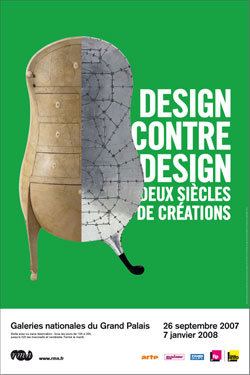Design by Design
dal 25/9/2007 al 6/1/2008
Segnalato da
25/9/2007
Design by Design
Galeries nationales du Grand Palais, Paris
Two Centuries of Creativity

Two Centuries of Creativity
curated by Jean-Louis Gaillemin
An exhibition organised by the Réunion des musées nationaux
Since the sixties and the post-modern impact of the eighties, the word ‘design’ has been in trouble. Prey to individual interpretations and long banned from institutional language in France, the word has undergone such inflation that it has become synonymous with “well drawn” or even “trendy”.
Design by Design brings together objects and household furniture from the Industrial Revolution to the present day. Rather than follow a chronological arrangement, which is too complex these days, it juxtaposes and draws parallels, triggers surprising short circuits and sparks dialogue between things. This dialogue is enriched by a set of broad essays in the catalogue touching on design and art, fashion, architecture, film, comic books, humour and novels.
FORM
The exhibition starts with formal comparisons: straight lines and geometry, curves and biomorphism, playing with form until it teeters on the brink of imbalance, deformity, formlessness. A library stepladder-stool designed by Joseph Hoffman in 1903 compared with a work by Sol Lewitt, or a wooden sofa by Dannhauser (1825) next to a corrugated cardboard ‘bubble’ chair by the architect Frank O.Gehry (1979) raise questions about the relationship between form and technique. The chairs Thonet designed for a neo-rococo drawing room became the famous “bistrot chairs”. Marcel Breuer’s ‘Wassily’ chair (1925) owes its shape more to nomadic fantasies of bicycles and nineteenth-century camping chairs than to “good design”.
CONTEXT
Next the exhibition looks at the influence of context on industrial design: how is an object shaped by what surrounds it, from the user – the human being – to nature in various forms? Objects like Gaetano Pesce’s Donna or Roger Tallon’s Phantom act like doubles or partners. Plants lend their lines and image to things. Animals are domesticated as bars, consoles, even seats. From baroque grottoes to carpets by Piero Gilardi the mineral kingdom adds its note, linking us to our ancestors the Flintstones. Duchamp and his followers retrieved ready-made objects and have made them part of design. From Russian ‘back to the earth’ armchairs of 1880 to the accumulations of the Campana brothers or Stuart Haygarth, industrial or discarded objects have taken a new lease on life.
ARCHITECTURE
A distinction is drawn between objects inspired by architecture and objects that claim to be architecture. Classical cabinets by Piero Fornassetti, Towers by Ettore Sottsass, “Sunset over Manhattan” by Gaetano Pesce play with proportions and Gulliver’s fantasies. But when a seat becomes a shell or a sofa folds in on itself, it becomes a protective, isolating envelope. From the Biedermeier shell seat to Eero Aarnio’s sphere and the Bouroullec brothers’ raised enclosed bed (Lit Clos) we see a trend towards cocoon furniture shared by many contemporary artists and architects.
STYLES
Providing a break in the exhibition, the two rotundas which join the galleries together explore the persistence of western or exotic styles with a few star pieces such as Jeroen Verhoeven’s Cinderella desk, a radiator with concrete branches by Joris Laarman or Robert Stadler’s exploded sofa.
Three monumental pieces anchor the circuit: Zaha Hadid’s Iceberg bench, Womb House by the Van Lieshout studio and a Visiona by Verner Panton.
Galeries nationales du Grand Palais
Place Clemenceau - Paris
Hours: Open daily except Tuesdays from 10am to 8pm and 10am to 10pm on Wednesdays and Fridays.
Last admission 45 minutes before closing
Admission: 10euro ;concession, 8euro (13-25 years, large families, job seekers) free for children under 13.



